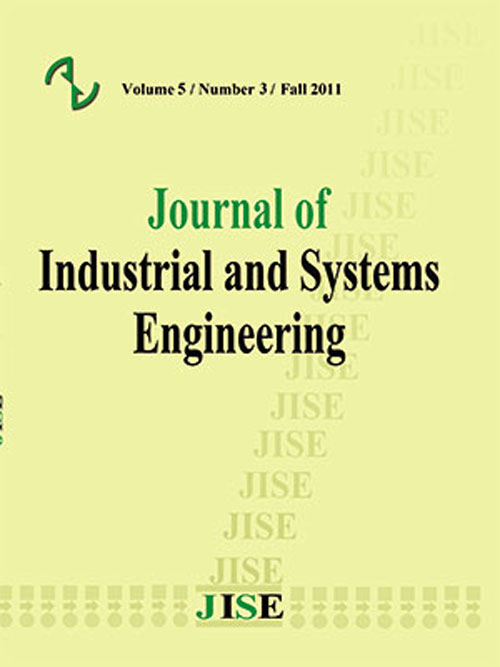فهرست مطالب
Journal of Industrial and Systems Engineering
Volume:1 Issue: 4, Winter 2008
- تاریخ انتشار: 1386/11/11
- تعداد عناوین: 6
-
-
Page 281The Mahalanobis Taguchi System (MTS) is a diagnosis and forecasting method for multivariate data. Mahalanobis distance (MD) is a measure based on correlations between the variables and different patterns that can be identified and analyzed with respect to a base or reference group. MTS is of interest because of its reported accuracy in forecasting small, correlated data sets. This is the type of data that is encountered with consumer vehicle ratings. MTS enables a reduction in dimensionality and the ability to develop a scale based on MD values. MTS identifies a set of useful variables from the complete data set with equivalent correlation and considerably less time and data. This paper presents the application of the Adjoint Matrix Approach to MTS for vehicle braking to identify a reduced set of useful variables in multidimensional systems.
-
Page 293A characteristic of data envelopment analysis (DEA) is to allow individual decision makingunits (DMUs) to select the most advantageous weights in calculating their efficiency scores.This flexibility, on the other hand, deters the comparison among DMUs on a common base. For dealing with this difficulty and assessing all the DMUs on the same scale, this paper proposes using a multiple objective linear programming (MOLP) approach for generating a common set of weights in the DEA framework.
-
Page 304In this paper, we develop a new mathematical model for a cyclic multiple-part type threemachine robotic cell problem. In this robotic cell a robot is used for material handling. The objective is finding a part sequence to minimize the cycle time (i.e.; maximize the throughput) with assumption of known robot movement. The developed model is based on Petri nets and provides a new method to calculate cycle times by considering waiting times. It is proved that scheduling problem of a robotic cell is unary NP-complete. Achieving an optimal solution for this type of complex, large-sized problem in reasonable computational time by using traditional approaches and optimization tools is extremely difficult. In this paper we implement an algorithm based on the particle swarm optimisation (PSO) method for solving the problem. To validate the developed model and solution algorithm, various test problems are examined some of which are of small-size and some other of large-size. The computational results show that the proposed algorithm achieves optimum solutions for small sized problems, while for large-sized problems this algorithm can find suitable solutions in acceptable time.
-
Page 318One of the designs of cellular manufacturing systems (CMS) requires that a machine population be partitioned into machine cells. Numerous methods are available for clustering machines into machine cells. One method involves using a similarity coefficient. Similarity coefficients between machines are not absolute, and they still need more attention from researchers. Although there are a number of similarity coefficients in the literature, they do not always incorporate the important properties of a similarity coefficient satisfactorily. These important properties include alternative routings, processing time, machine capacity (reliability), machine capability (flexibility), production volume, product demand, and the number of operations done on a machine. The objectives of this paper are to present a review of the literature on similarity coefficients between machines in CMS, to propose a new similarity coefficient between machines incorporating all these important properties of similarity, and to propose a machinecell heuristic approach to group machines into machine cells. An example problem is included and demonstrated in this paper.
-
Page 345In this paper, we first introduce a generalized version of open shop scheduling (OSS), called generalized cyclic open shop scheduling (GCOSS) and then develop a hybrid method of metaheuristic to solve this problem. Open shop scheduling is concerned with processing n jobs on m machines, where each job has exactly m operations and operation i of each job has to be processed on machine i. However, in our proposed model of GCOSS, processing each operation needs more than one machine (or other resources) simultaneously. Furthermore, the schedule is repeated more than once. It is known that OSS is NP-hard. Therefore, for obtaining a good solution for GCOSS, which is obviously NP-hard, a hybrid algorithm is also developed. This method is constructed by hybridizing ant colony optimization (ACO), beam search and linear programming (LP). To verify the accuracy of the method, we also compare the results of this algorithm with the optimal solution for some special problems.
-
Page 360In real world scheduling applications, machines might not be available during certain timeperiods due to deterministic or stochastic causes. In this article, the machine scheduling with availability constraints for both deterministic and stochastic cases with different environments, constraints and performance measures will be discussed. The existing body of research work in the literature will be completely reviewed and the NP-complete models will be identified.


